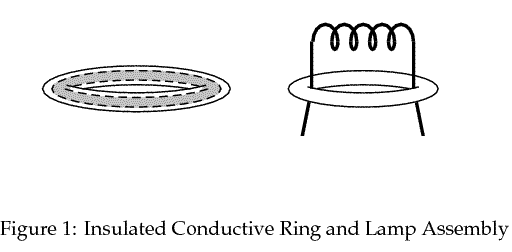
Conventional strings of incandescent Christmas tree lights have the annoying defect that when one of the lamps fails the entire string goes dark. This is because the typical failure mode is caused by a hot spot on the filament which eventually melts interrupting the current flow through the rest of the string.
An improvement on this situation has been found which results in light strings that remain on when one or more lamps fail. The solution
is an ingenious example of simple, but far from obvious, technology. It consists of a
conductive metal ring which is coated with a suitable insulating plastic or a thin layer of oxide. A diagram of such a ring is shown in the
figure below.

The ring is used by gently placing it on the wires which support the filament also shown in the figure.
Here's how it works. In ordinary use, the ring is insulated from the electrical support wires and, because of the low voltage present,
it has no affect on the operation of the lamp. But when a filament burns out, interrupting the current flow,
the full line voltage appears across the supporting wires. This voltage
is sufficiently high to arc through the thin insulation, welding the ring to the support wires.
When the ring is welded to the support wires, current can again flow and the remaining lights in the string stay on. However, note that
the replacement of the low resistance of the failed lamp with a short circuit slightly increases the current in the string. The other lamps
will glow a little brighter than before.
The failed lamp is easily spotted, as it is the only one which is dark. If it is now replaced, all is as before. But if the lamp is not
replaced, eventually another lamp may fail. Successive failures can cause the current in the string to steadily increase, and this is
where a secondary feature of the conductive ring comes into play.
The ring is designed to carry a specific current before it, too, will melt. It is actually a carefully engineered fuse and, as such,
can prevent a runaway hazard which might otherwise occur in the careless, unattended operation of the light string.